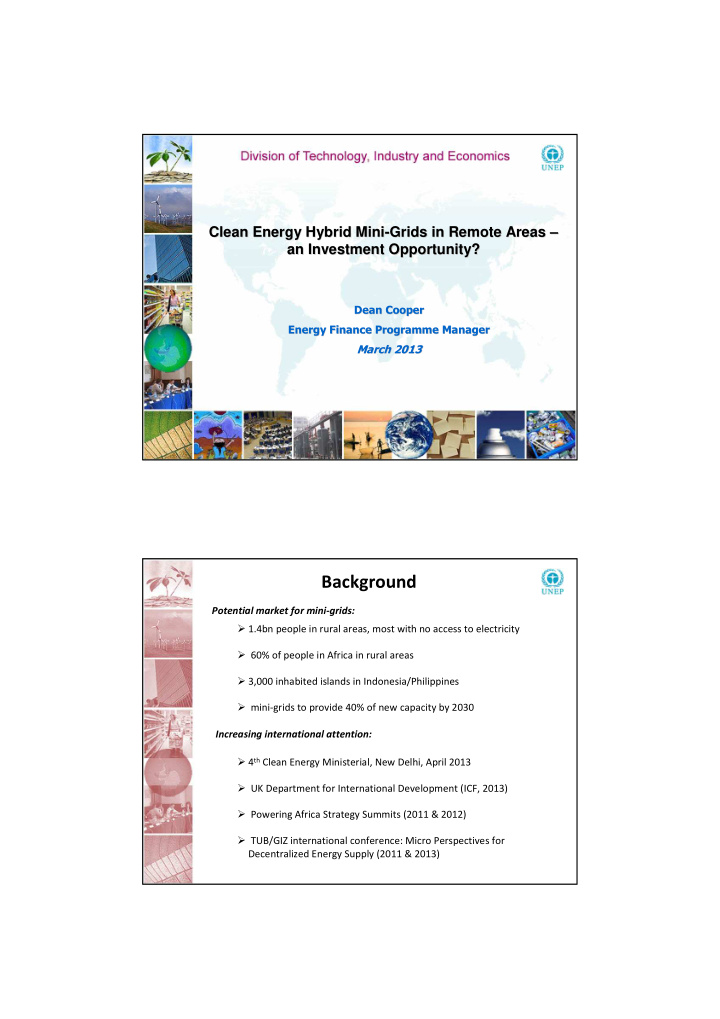



Clean Energy Hybrid Mini- -Grids in Remote Areas Grids in Remote Areas – – Clean Energy Hybrid Mini an Investment Opportunity? an Investment Opportunity? ����������� ����������� �������������������������������� �������������������������������� ���������� ���������� Background Potential market for mini-grids: � 1.4bn people in rural areas, most with no access to electricity � 60% of people in Africa in rural areas � 3,000 inhabited islands in Indonesia/Philippines � mini-grids to provide 40% of new capacity by 2030 Increasing international attention: � 4 th Clean Energy Ministerial, New Delhi, April 2013 � UK Department for International Development (ICF, 2013) � Powering Africa Strategy Summits (2011 & 2012) � TUB/GIZ international conference: Micro Perspectives for Decentralized Energy Supply (2011 & 2013)
Viable Business Model - Challenges • High up-front costs • Long-term revenues • Role of public funding • Local management of operations • Risks from political/regulatory uncertainty Viable Business Model – Key Factors • Understand customer demand • Raise customer awareness • Maximize and optimize revenues • Minimize cost exposure • Minimize risks
Bottom-up Approach • What is the demand – 24/7? • Sufficient scale for returns – ABC? • Brownfield / greenfield • Need for hybrids • Community ownership • Technology selection – local resources Mini-grid Power Back-up Options • Batteries • Fuel cells • Diesel generators • Local renewable resources • Bio-energy
Use of Bio-energy? • Land-use planning • Technology options and potential • Implementation options and impacts • Stakeholder engagement • Assessment tools • Certification and standards Role of the Public Sector • Guarantees for initial investment • Policy framework • Tariff structure • Economies of scale • Public-private-partnership
Preparing for Investment Feasibility depends upon: • Technology to match needs • Stable policy framework • Sufficient capacity building • Understanding local conditions • Price sufficient for re-investment • Experience of practical implementation in targeted local communities Proposed UNEP Demonstration • Assessment of likely demand • RE hybrid based on local resources and bio- energy • Selection of 3-5 countries • Implementation of different financial models • Measurement of impact • Development of a best practice approach for future mini-grid providers
Target Groups • Local communities • Technology providers • Local financiers • National policy-makers • Local government • Local suppliers and installers • International organisations Key Requirements from Public and Private Sector
Current Target Countries Mini-grids for “remote areas” - rural areas in Africa, islands in Asia: • Kenya • Tanzania • Uganda • Namibia • Philippines • Indonesia UNEP Approach
Intended Outcomes • Increased local access to energy supply from connection to a local minigrid • Financiers aware and interested • Customer demand • National policy to encourage mini-grid installation • Reduced CO2 emission outlook • Social, gender and economic upliftment • Sustainable demonstration => replication potential
Recommend
More recommend